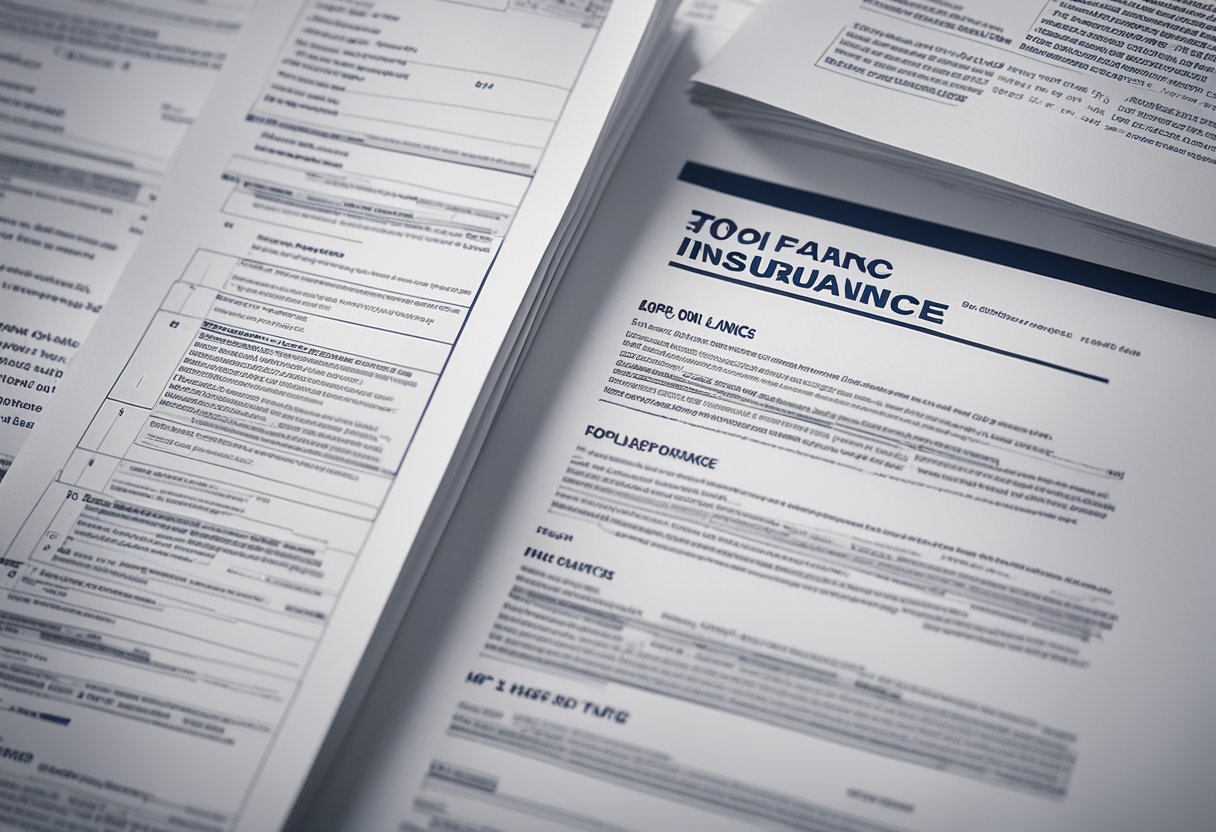Understanding Insurance Basics
Insurance offers financial protection against unexpected events. Knowing the different types of policies and how to evaluate your needs is essential for making informed choices.
Types of Insurance Policies
There are several main types of insurance policies people consider. Each type serves a specific purpose based on personal or professional needs.
- Health Insurance: Covers medical expenses for injuries and illnesses.
- Auto Insurance: Protects against financial loss from vehicle accidents.
- Homeowners Insurance: Offers protection for homes and personal property against risks like theft or damage.
- Life Insurance: Provides financial support to beneficiaries after the policyholder’s death.
Understanding these types helps individuals identify what coverage they require based on their unique circumstances.
Evaluating Coverage Needs
Evaluating specific coverage needs is crucial for selecting the right insurance policy. Individuals should assess various factors.
- Personal Assets: Consider the value of owned assets like cars, homes, and savings.
- Risk Factors: Analyze personal circumstances, such as health, driving habits, and lifestyle choices.
- Family Needs: Think about family obligations, including dependents who may need financial support.
By evaluating these elements, a person can make informed decisions about the amount and type of coverage necessary for their situation.
Insurance Terminology Explained
Understanding common insurance terms is key to navigating policies effectively. Here are important terms to know:
- Premium: The amount paid for the insurance policy, typically monthly or annually.
- Deductible: The out-of-pocket cost the policyholder pays before insurance coverage kicks in.
- Coverage Limit: The maximum amount the insurance will pay in the event of a claim.
- Exclusions: Specific situations or conditions not covered by the policy.
Familiarity with these terms will help individuals understand their policies better and ensure they select appropriate coverage.
Assessing Your Insurance Requirements

Assessing insurance requirements involves understanding individual needs and determining how much coverage is necessary. This careful evaluation helps in crafting a tailored insurance plan that provides adequate protection, whether for personal use or for a family.
Personal vs. Family Coverage
When choosing insurance, individuals must decide between personal and family coverage. Personal coverage is designed for the individual and their specific needs. It typically covers personal assets like a vehicle or home.
In contrast, family coverage extends protection to multiple family members. This type of policy often includes options for health, life, and home insurance. It is essential to evaluate how many family members need coverage and what assets should be protected.
Key Considerations:
- Assess individual assets and liabilities.
- Determine health needs for each family member.
- Consider future changes, like expanding the family.
Calculating Adequate Sum Insured
Determining the right sum insured is crucial for adequate protection. It should reflect the total value of assets being insured and potential liabilities. For instance, a home’s value, contents, and liabilities must all be taken into account.
One method to assess this is to create a detailed list of all possessions. Calculate replacement costs, not just current market value. This ensures that in the event of a loss, there is enough coverage to replace items without incurring out-of-pocket expenses.
Steps for Calculation:
- List Assets: Include homes, vehicles, and valuables.
- Estimate Replacement Costs: Research current market prices.
- Consider Future Needs: Anticipate any changes in lifestyle or assets.
By following these guidelines, individuals can ensure they are adequately covered.
Comparing Insurance Providers

When selecting an insurance provider, it is crucial to look beyond just the policy details. Factors such as reputation, customer service, and claim settlement ratios significantly impact the overall experience. These elements help ensure the chosen provider aligns with the needs of the policyholder.
Reputation and Reliability
The reputation of an insurance provider plays a key role in decision-making. Reliable providers are known for their financial stability and positive customer feedback. Prospective policyholders can research this by checking reviews and ratings from independent organizations.
Things to consider:
- Financial Ratings: Look at ratings from agencies like A.M. Best or Moody’s, which assess the insurer’s financial strength.
- Market Presence: A long-standing presence in the market often indicates reliability.
- Consumer Feedback: Online platforms can provide insights into customer experiences.
Customer Service and Support
Good customer service is essential when choosing an insurance provider. An insurer with strong support is more likely to assist individuals effectively during claims or inquiries. Timely responses and easy communication channels are vital.
Important aspects to evaluate:
- Availability: Check if support is available 24/7 via multiple channels like phone, chat, or email.
- Response Time: Assess how quickly the company responds to queries.
- Customer Satisfaction Scores: Look at surveys and ratings that measure customer satisfaction.
Claim Settlement Ratio
The claim settlement ratio indicates how many claims an insurer settles compared to the total claims made. A higher ratio often reflects a policyholder-friendly approach.
Key points to review:
- Ratio Understanding: A claim settlement ratio above 90% is generally considered good.
- Trends: Look for trends over the past few years to assess consistency.
- Claims Process: Research how straightforward and transparent the claims process is, including any required documentation.
By examining these aspects, individuals can make a well-informed choice when comparing insurance providers.
Analyzing Policy Features

When selecting an insurance policy, understanding its features is crucial. This section focuses on key aspects individuals should evaluate, including core benefits, add-on covers, and exclusions to ensure the right choice aligns with their needs.
Core Benefits
Core benefits refer to the primary coverage offered by an insurance policy. These are essential elements that protect individuals against significant risks. For instance, in a life insurance policy, the core benefit is the death benefit paid to beneficiaries upon the insured’s passing.
In health insurance, core benefits typically cover hospital stays, surgeries, and necessary medical treatments. It’s important for individuals to review these benefits carefully. They should ensure that the benefits meet their specific needs, considering factors like family health history and lifestyle.
When comparing policies, he or she should evaluate the coverage limits and deductibles. Higher limits may provide better protection but could lead to higher premiums. Thus, understanding these features helps individuals choose a plan that offers valuable coverage.
Add-On Covers
Add-on covers are optional features that enhance the main policy. They allow individuals to customize their coverage based on personal needs. Common examples include critical illness riders, accidental death benefit riders, and disability coverage.
Choosing add-on covers can provide additional protection at a reasonable cost. For instance, a critical illness rider can offer a lump-sum payment upon diagnosis of certain conditions, helping with medical expenses. This extra coverage can fill gaps in the core policy.
Before adding these options, it’s essential to evaluate whether they align with personal circumstances. Individuals should consider their health risks, financial situation, and the likelihood of needing additional coverage. This careful consideration will help manage future risks effectively.
Exclusions and Limitations
Exclusions and limitations outline what the policy does not cover, influencing its effectiveness. Most insurance policies include specific exclusions for risks that are not insurable. Common exclusions include pre-existing conditions, certain types of accidents, and high-risk activities.
Understanding these exclusions is vital. If a situation arises that is excluded from a policy, individuals may find themselves without financial protection when needed most. Therefore, he or she should carefully read the terms of the policy.
Limitations also affect the coverage amount available in specific situations. For example, some policies may limit payouts for specific conditions or incidents. Knowing these limitations helps individuals assess the real value of a policy and choose one that provides comprehensive coverage.
Investigating Premium Determinants

When choosing an insurance policy, understanding the factors that influence premium rates is essential. Two key areas affecting premiums are age and health factors, along with lifestyle and occupation risks.
Age and Health Factors
Insurance companies often assess age and health before setting premiums. Younger individuals may pay lower rates because they are considered lower risk. Conversely, older individuals may face higher costs due to increased health risks.
Health conditions significantly impact premium amounts. Those with chronic illnesses or a history of serious health issues may see higher premiums. Insurers often require medical exams to determine risk levels.
A simple overview of age and health influences on premiums:
- Age: Younger = lower rates, Older = higher rates
- Health Conditions: Chronic illnesses increase costs
Lifestyle and Occupation Risks
Lifestyle choices, such as smoking or engaging in risky hobbies, can raise premium costs. Smokers may face significantly higher rates due to health risks associated with tobacco use.
Occupation also plays a crucial role in determining premiums. Jobs that have higher injury rates or hazardous conditions can lead to increased insurance costs. Examples include construction workers or pilots.
Key factors relating to lifestyle and occupation include:
- Smoking: Higher premiums for smokers
- Hobbies: Risky activities can increase costs
- Occupation: High-risk jobs raise insurance rates
Being aware of these factors can help individuals make informed choices when selecting an insurance policy.
Evaluating Long-Term Benefits

When selecting an insurance policy, long-term benefits play a crucial role. Understanding renewal policies, available bonuses and discounts, and any investment components can significantly influence decision-making. Each of these aspects can add substantial value to an insurance plan.
Renewal Policies
Renewal policies outline the terms for extending coverage after the initial period ends. It’s essential to know how premiums may change upon renewal. Some policies offer a guaranteed renewal option, protecting against price hikes as one ages.
Key factors to consider include:
- Premium Increases: Understand how premiums may change during renewals.
- Coverage Continuity: Ensure the policy allows for consistent coverage without gaps.
- Options for Upgrades: Check if policyholders can enhance their coverage as needs change.
Evaluating these elements helps secure long-term peace of mind.
Bonus and Discounts
Insurance companies often provide bonuses and discounts for various reasons. Knowing what is available can lead to significant savings. Common types of bonuses might include:
- Loyalty Discounts: Some insurers reward long-term customers with reduced rates.
- Bundling Discounts: Combining multiple policies, like home and auto, can lower total premiums.
- Wellness Incentives: Health programs can offer savings for policyholders improving their well-being.
Understanding these options can enhance value and affordability in long-term coverage.
Investment Components
Some insurance policies include investment components, offering both protection and a way to grow wealth. This can make policies more appealing for those considering their long-term financial strategy. Important points to explore include:
- Cash Value Accumulation: Policies like whole life insurance build cash value over time, which policyholders can borrow against.
- Investment Options: Some products allow for investment in stocks or bonds, potentially yielding higher returns.
- Tax Benefits: The growth in cash value often enjoys tax-deferred status, offering financial advantages.
Exploring these investment elements can lead to more informed choices about long-term policies.
Reviewing the Claims Process

Understanding the claims process is essential for policyholders. Knowing how to document claims, the expected turnaround times, and available assistance can make the experience smoother and less stressful.
Documentation and Procedures
Documentation is a crucial step in the claims process. Policyholders should keep detailed records of incidents, including photographs of any damages or losses. It’s essential to write down specific details about when and how the event occurred. These records serve as reliable evidence when filing a claim.
Once the documentation is complete, policyholders must follow their insurer’s procedures for submitting a claim. This usually involves filling out a claim form, which can often be found on the insurance company’s website or obtained directly through a representative. Being thorough and accurate in this step can prevent delays.
Turnaround Times
Turnaround times for claims can vary widely based on several factors, including the complexity of the claim and the insurer’s practices. Many companies aim to process simple claims within a few days, while more complicated claims may take weeks or even months.
To get a better idea of expected timelines, policyholders can ask their insurance agents for specific benchmarks. Being informed about these timelines helps manage expectations. If delays occur, it is important for policyholders to follow up with the insurer regularly for updates.
Assistance During Claims
Navigating the claims process can be daunting, but assistance is available. Most insurance companies have dedicated claims adjusters who guide policyholders through the steps needed. They provide essential information and support, ensuring that policyholders understand what is required at each stage.
In addition, many insurers offer online resources, including FAQs and chat support, to help address common questions. Utilizing these tools can lead to a more efficient claims experience. If issues arise, policyholders are encouraged to contact their insurance agents for personalized help and guidance.
Considering the Insurer’s Financial Health

When choosing an insurance policy, examining the insurer’s financial health is crucial. A financially stable company is more likely to meet its claims obligations.
Key Indicators of Financial Health:
- Credit Ratings: Look at ratings from agencies like A.M. Best or Standard & Poor’s. High ratings indicate a strong ability to pay claims.
- Claims Payment History: Research the insurer’s track record for settling claims on time. This reflects their reliability.
- Financial Reports: Review the insurer’s annual financial statements. Strong revenue and profit margins suggest stability.
Why It Matters:
If an insurer is financially unstable, it may struggle to pay claims during significant events. This can leave policyholders in tough situations.
Tips for Researching Financial Health:
- Use online resources to find ratings and reviews.
- Compare different insurance companies to see how they rank.
- Seek expert advice if needed.
By understanding the insurer’s financial situation, individuals can make informed choices about their insurance policies. A solid understanding will help them feel more secure about their coverage.
Leveraging Online Reviews and Ratings

Online reviews and ratings provide valuable insights when choosing an insurance policy. They can guide individuals in making informed decisions.
When evaluating different insurance companies, consider these points:
- Trustworthiness: Look for reviews on reliable sites. Websites like NerdWallet and Forbes offer evaluations based on customer experiences.
- Customer Service: Read about others’ experiences with claims and support. This can reveal how a company handles issues.
- Policy Options: Reviews often highlight specific insurance types. For example, some policies may be better suited for certain needs, like term or whole life insurance.
- Cost Comparison: Ratings can show how companies rank concerning pricing. A higher rating may indicate better value for the premiums paid.
Key aspects to check include:
- Rating Scores: Look for scores from organizations like J.D. Power and A.M. Best.
- Customer Feedback: Note recurring themes in reviews. Positive comments about claims processing or negative feedback on policy denials can be telling.
- Expert Reviews: Use articles that summarize multiple reviews. For instance, NerdWallet’s reviews and Forbes’ rankings often include details about top companies.
By using online reviews and ratings, individuals can better navigate their options and find a policy that fits their needs.
Understanding Policy Riders and Endorsements

Policy riders and endorsements are important aspects of insurance policies. They help customize coverage to fit individual needs. While both serve to modify a policy, they have different functions.
Endorsements are additions to the existing policy. They can:
- Add coverage to the policy
- Limit or delete certain coverages
- Add or remove people or locations
These changes adjust the overall terms of the policy.
Riders, on the other hand, provide extra coverage without changing the main policy terms. They often cover specific scenarios not included in the base policy, such as:
- Accidental Death
- Long-term Care
- Critical Illness
Riders enhance protection for unique situations.
It’s essential for individuals to understand these tools. They maximize the effectiveness of an insurance policy. By using riders and endorsements correctly, one can tailor their insurance to better protect their assets and meet personal needs.
When choosing a policy, it is wise to discuss available riders and endorsements with an agent. This helps ensure that the policy offers comprehensive coverage suited to specific circumstances. Knowing the differences can lead to more informed choices in insurance products.
Navigating Policy Renewal and Cancellation

Understanding how to handle policy renewal and cancellation is essential for any insurance policyholder. Knowing the specific conditions and terms can help individuals make informed decisions and avoid unexpected issues.
Renewal Conditions
Many insurance policies automatically renew at the end of their term, usually every six or twelve months. Policyholders should be aware of their insurer’s renewal process and any changes that may occur.
Before renewal, it is wise to review coverage limits, deductibles, and any new policy features. Insurers are required to send advance notice of renewal terms. This notice often includes a breakdown of costs and any changes to coverage.
It is important to know if there will be any changes in premiums. Increased rates could affect a policyholder’s budget. If the rates seem high, eight weeks before the renewal date is a good time to shop around and compare different providers.
Cancellation Terms
Cancellation terms vary by insurer and policy type. Policyholders should understand the reasons an insurer may cancel a policy, such as non-payment, fraud, or a significant change in risk.
Insurers typically provide written notice before cancellation, detailing the reason and the effective date. Policyholders have the right to ask for a review or appeal the cancellation decision.
Some policies may include cancellation fees. It’s essential to check the policy terms before deciding to cancel. Keeping an eye out for these fees can prevent unexpected charges.
When considering cancellation, it might benefit a policyholder to explore alternatives, such as lower deductibles or discounts for safe driving. These options could lead to better rates and retained coverage.
Planning for Future Insurance Needs

Preparing for future insurance needs requires careful consideration of personal circumstances and potential life changes. As individuals navigate through different stages of life, their insurance requirements may shift. Adjustments are essential to ensure adequate coverage.
Scaling Coverage with Life Changes
Life changes, such as marriage, childbirth, or job changes, often necessitate updates to insurance coverage. For example, when a couple gets married, they may need to combine their policies or increase their coverage limits. Similarly, having a child usually means it’s time to add them to health and life insurance plans.
When assessing coverage needs, it’s essential to evaluate current assets and liabilities. A good practice is to make a list of significant life events and adjust insurance coverage accordingly. This way, they ensure that their policies protect them and their loved ones adequately.
Policy Upgradation Options
Upgrading an insurance policy is a vital consideration as personal situations evolve. Many insurance providers offer options for policy upgrades, allowing individuals to adjust their coverage limits or add features as needed.
For instance, a homeowner might want to increase their property insurance limit after making renovations. In those cases, they should communicate with their insurance agent about potential upgrades. It is also helpful to review policy terms regularly to understand what options are available.
Before upgrading, individuals should compare costs and benefits of different policies. This comparison helps to find the best coverage at a reasonable price, ensuring they meet their future insurance needs effectively.





